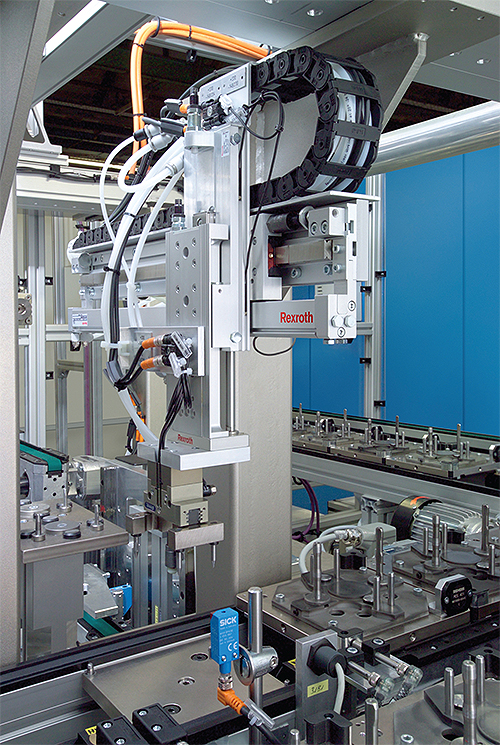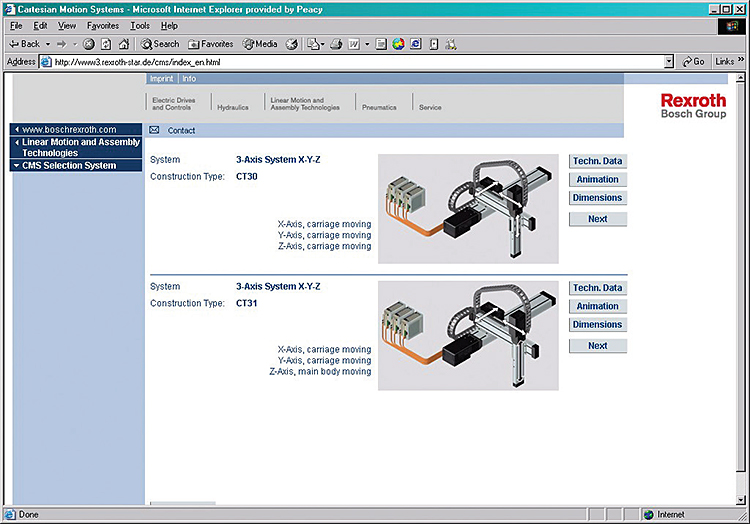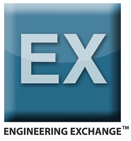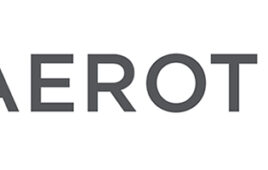By Danielle Collins, Industry Segment Manager, Bosch Rexroth Linear Motion and Assembly Technologies, Buchanan, Mich.
Everything from initial research and design, through acquisition and startup costs, and system operation and maintenance contributes to total cost of ownership (TCO) in linear motion systems.

A well-implemented multi-axis manufacturing system can cut production time, increase throughput, and improve quality and profits.
In the industrial world of capital equipment, it’s easy to add unexpected costs to the ownership experience, both before and after the purchase, if you look only at the initial purchase price. The “cheap” solution in the short term may end up costing you more in the long run, especially in the world of linear motion systems.
Linear motion systems, also referred to as linear modules or electromechanical actuators, typically combine a linear drive mechanism, such as a precision ball screw or toothed belt, with a linear guide system, often a ball rail or cam roller guide assembly, inside a housing to create a single linear axis. Many sizes and styles are available, which makes it easy to combine them into custom multi-axis systems for a range of applications. Extremely small systems can be combined to create a 3-axis dispensing system for laboratory automation, for example, or very large systems can be used to build a handling system for heavy automotive components.
More integrated systems require motors, drive amplifiers and controllers, and to simplify specification and ordering, some linear motion companies have begun offering complete, pre-configured Cartesian motion systems. Medical manufacturing and packaging companies often choose these pre-configured, pre-assembled systems to eliminate the time and hassle of mounting and aligning multiple axes, selecting the proper motor and drive combination, and designing mounting interfaces, which allows them to focus on their expertise; device manufacturing, high throughput screening, or packaging.

A typical belt-drive linear actuator provides higher speeds and longer lengths than typical screw drive actuators. Screw drive systems, however, can offer higher precision and higher load capacities.
TCO applied to linear motion
The TCO principle was first defined in the 1980s to quantify the cost of implementing personal computers in the workplace. Since then, TCO theory has been applied widely throughout all major industries, including manufacturing, to analyze the lifetime costs of major assets. A well-implemented Cartesian robot or other multi-axis manufacturing system, for example, can not only cut production time and increase throughput, but can also improve quality and profits. If poorly implemented, however, those profits can disappear in re-work, re-design, or unexpected maintenance costs.
So what factors should you consider when evaluating the costs of a linear motion system? Consider costs in terms of three separate phases:
• Pre-purchase activities such as design and specification
• Purchasing, which includes ordering, taking delivery, system assembly and startup
• The post-purchase phase, including maintaining and re-purposing the system
The Pre-purchase phase: The critical starting point
The pre-purchase phase is the most important for implementing a linear motion system. Here, the cost elements influencing TCO depend on the time required to design, specify, and purchase the appropriate linear motion system. Making good choices in the pre-purchase phase can save time in designing the system and in sourcing the components. It also ensures smooth startup and trouble-free operation. With good planning, it’s possible to save some money early on without causing trouble later.
The key to success in this phase is sizing and selecting the appropriate linear module or modules for your system. To make the sizing and selection process easier, most linear motion companies offer resources such as web-based sizing and selection tools. A typical three-axis Cartesian system normally requires at least 17 hours of engineering time just to size the system to adequately handle the application requirements — not undersized or oversized. For example, laboratory automation often calls for smaller systems. If the system is larger than the application requires, you’ve wasted both money and space.
Good sizing tools can guide you through the main factors to be considered, and can cut this time to three hours or less. Coupled with automated drawing generators, which provide instant access to 2-D and 3-D models even for complex systems, you can save quite a bit in engineering costs alone.
Cost savings resulting from good planning go well beyond saved engineering time. Consider the consequences of a poorly engineered system. A system that isn’t robust enough to handle the application leads to waste due to poor performance, lost productivity and lost revenue from missed market launch opportunities. Factor in the extra cost and hassle of removing the ineffective system, re-sizing the application, re-ordering, re-installing, and starting up a new system and the wasted time and money involved can easily exceed thousands of dollars and, if you’re a machine builder, may cost you a customer.
The Purchase phase: That red tape is expensive
Once the linear motion system is selected and designed into the application, the system is purchased. Some companies can provide a single part number for a complete, multi-axis electromechanical system, making the ordering process easier by simply reducing 20 or 30 part numbers down to one. The result: Savings in the number of vendors, purchase orders, and line items, further leading to time savings throughout the approval, procurement and receiving processes. At $100 processing cost per purchase order, savings could add up to another $2,000 or more per system. And if you need to order a duplicate system, repeat cost savings are already built in.
After receiving the system, a lot of time can be spent assembling and starting it up. To reduce cost at this stage, it’s important to choose a system that’s easy to install and doesn’t require complex start-up procedures. Pre-assembled linear modules and Cartesian systems offer the least complexity, as 80% of the assembly, integration, and programming work is done by the manufacturer. Recognizing these cost savings, many system integration companies are using pre-configured Cartesian systems to cut their costs and lead times and, as a competitive edge, are passing those savings along to their end-users. In conjunction with pre-assembled systems, user-friendly Human Machine Interfaces (HMIs) and programming protocols can save more time and money by providing machine-builders and end-users with simple open-based programming options.

Online sizing tools, like Rexroth’s CMS configurator, take much of the guesswork out of selecting the right modules for the overall system. The Rexroth website features many such tools at www.boschrexroth-us.com/tools.
The Post-purchase phase: What does “lubed for life” mean, exactly?
After the system is put into service, maintenance work can add several thousand dollars to the cost of ownership over the life of the system. This is a key area often underestimated by machine designers.
Some linear products are marketed as “lubed for life.” However, it’s important to note that the life (number of meters or revolutions traveled) is often defined with no load applied to the system. Be sure you understand the manufacturer’s “fine print.” When a load of just 100 pounds is applied, the life of these “lubed for life” components can be reduced by five times, for example, from 25,000 km to 5,000 km. For a machine with 1-meter stroke, traveling at 1 m/s for 16 hours per day, this equates to approximately one full year of life that is lost. If the scheduled replacement of the linear motion system is every three years, then a lost year of life increases the replacement frequency by 33%.
To reduce maintenance or replacement costs, choose a linear motion system that incorporates full contact seals, which preserve lubrication inside the moving components and prevent contamination from entering. Also, reduce re-lubrication time and effort by choosing a system with easy-to-access lube ports or the capability of using an automatic lube system. The maintenance personnel will appreciate such a design.
Beyond lubrication and preventive maintenance, it’s sometimes necessary to repair or upgrade a machine in order to increase performance, which often involves changing or upgrading the linear motion system. In many cases, the entire linear system doesn’t need to be upgraded or replaced, just one or two components. Some manufacturers make it easy to replace only a part of their system by offering interchangeable components such as profiled rails and runner blocks. Such flexibility reduces not only the cost of the parts needed but also the time required to make the changes in the machine. With interchangeable components, the cost of replacing or upgrading a linear motion system can be reduced by 75%, for example, if only the runner block needs to be replaced, and not the profiled rail.
Look beyond just the price provided on the vendor’s quotation and consider the costs associated with specifying, designing, purchasing, and maintaining the system. Applying TCO considerations when specifying and buying manufacturing technologies can eliminate waste, improve worker satisfaction, enhance revenue and profits, and increase quality.
TCO Tips:
TCO considerations:
• Plan well: size and select the appropriate linear module(s) foryour system
• Use web-based sizing tools to reduce engineering time
• Consider pre-assembled linear modules for easy installation and quick start-up
• Reduce maintenance with full-contact seals to preserve lubrication
• Save time and money by choosing a system with interchangeable components
• Parts of the system can be repaired or upgraded rather than replacing the whole machine
Pitfalls in linear motion system implementation:
• A poorly implemented system costs hours of re-work, re-design and unexpected maintenance
• A system built too large for the application it serves consumes money and space
• A system not robust enough to handle the application results in poor performance and lost revenue from missed market- launch opportunities
Bosch Rexroth Linear Motion and Assembly Technologies
www.boschrexroth-us.com
::Design World::
Filed Under: Factory automation, LINEAR MOTION, Motion control • motor controls






Tell Us What You Think!